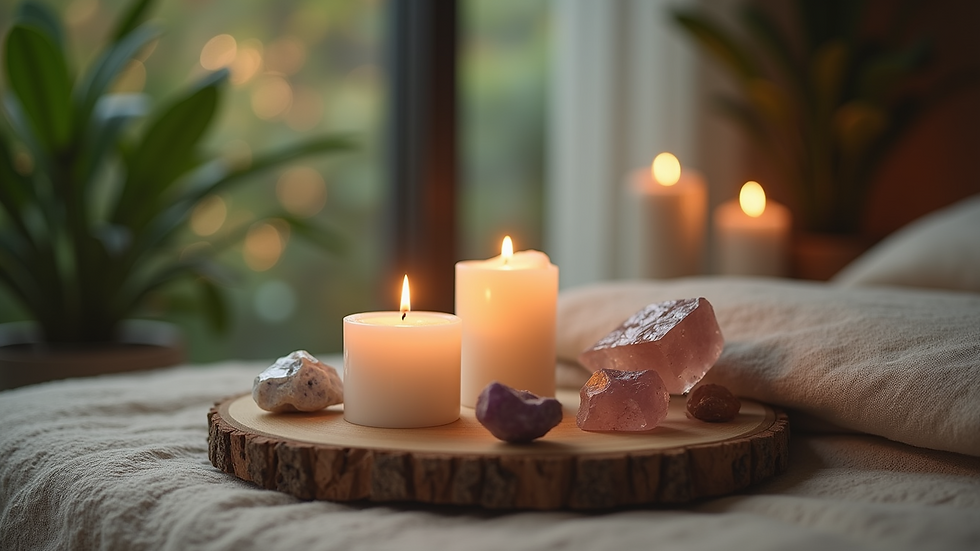Unveiling the Mysteries of Chakras Understanding the Energy Centers Within Our Body
- Silvia Metodieva
- 5 days ago
- 4 min read
Chakras are often described as the energy centers of the body, playing a crucial role in our physical, emotional, and spiritual well-being. Originating from ancient Indian traditions, the concept of chakras has gained popularity in modern wellness practices. This blog post aims to explore what chakras are, their significance, and how they influence our lives.
What Are Chakras?
Chakras are energy points located along the spine, each corresponding to different physical, emotional, and spiritual aspects of our being. The term "chakra" comes from the Sanskrit word for "wheel," symbolizing the spinning energy that flows through these centers. There are seven primary chakras, each associated with specific functions and characteristics.
The Seven Main Chakras
1. Root Chakra (Muladhara)
Located at the base of the spine, the root chakra is associated with our sense of security, stability, and grounding. It connects us to the earth and influences our basic survival needs, such as food, shelter, and safety. When balanced, individuals feel secure and confident in their environment.
2. Sacral Chakra (Svadhisthana)
The sacral chakra is situated just below the navel and is linked to creativity, pleasure, and emotional expression. It governs our relationships and the ability to experience joy. A balanced sacral chakra fosters healthy relationships and a vibrant creative life.
3. Solar Plexus Chakra (Manipura)
Located in the upper abdomen, the solar plexus chakra is the center of personal power and self-esteem. It influences our confidence, willpower, and decision-making abilities. When this chakra is balanced, individuals feel empowered and capable of achieving their goals.
4. Heart Chakra (Anahata)
The heart chakra is positioned at the center of the chest and is associated with love, compassion, and emotional healing. It serves as a bridge between the lower and upper chakras, balancing our physical and spiritual aspects. A balanced heart chakra allows for deep connections with others and a sense of inner peace.
5. Throat Chakra (Vishuddha)
Located in the throat area, the throat chakra governs communication and self-expression. It influences our ability to speak our truth and express our thoughts and feelings. A balanced throat chakra enables clear communication and authentic expression.
6. Third Eye Chakra (Ajna)
The third eye chakra is situated between the eyebrows and is associated with intuition, insight, and spiritual awareness. It governs our ability to see beyond the physical realm and tap into our inner wisdom. A balanced third eye chakra enhances intuition and clarity of thought.
7. Crown Chakra (Sahasrara)
The crown chakra is located at the top of the head and represents our connection to the divine and higher consciousness. It influences our spiritual growth and understanding of the universe. A balanced crown chakra fosters a sense of unity and connection with all living beings.

The Importance of Chakra Balance
Maintaining balance among the chakras is essential for overall well-being. When one or more chakras are blocked or imbalanced, it can lead to physical, emotional, or spiritual issues. For instance, a blocked heart chakra may result in difficulties in relationships, while an imbalanced solar plexus chakra can lead to low self-esteem.
Signs of Imbalanced Chakras
Recognizing the signs of imbalanced chakras can help individuals take proactive steps toward healing. Common symptoms include:
Root Chakra: Feelings of insecurity, anxiety, or financial instability.
Sacral Chakra: Creative blocks, emotional instability, or issues with intimacy.
Solar Plexus Chakra: Low self-esteem, indecisiveness, or lack of motivation.
Heart Chakra: Difficulty in forming connections, feelings of loneliness, or emotional pain.
Throat Chakra: Trouble expressing oneself, fear of speaking, or communication issues.
Third Eye Chakra: Lack of intuition, confusion, or difficulty in making decisions.
Crown Chakra: Feelings of disconnection from spirituality or a lack of purpose.
Techniques for Balancing Chakras
There are various methods to balance and align the chakras, including:
1. Meditation
Meditation is a powerful tool for chakra healing. Focusing on each chakra during meditation can help clear blockages and promote energy flow. Visualization techniques, such as imagining each chakra as a spinning wheel of light, can enhance this practice.
2. Yoga
Yoga poses are designed to open and balance the chakras. Specific poses target different chakras, promoting physical and energetic alignment. For example, the tree pose can help ground the root chakra, while the camel pose can open the heart chakra.
3. Sound Healing
Sound frequencies can resonate with specific chakras, promoting healing and balance. Chanting mantras, using singing bowls, or listening to specific frequencies can help align the energy centers.
4. Crystals
Crystals are believed to carry unique vibrational energies that can aid in chakra healing. For instance, red jasper is often used for the root chakra, while amethyst is associated with the crown chakra. Placing these crystals on the corresponding chakra during meditation can enhance energy flow.
5. Aromatherapy
Essential oils can also support chakra balancing. For example, sandalwood and patchouli are often used for the root chakra, while lavender and frankincense can help balance the crown chakra. Diffusing these oils or applying them topically can promote healing.
Conclusion
Understanding chakras and their significance can empower individuals to take charge of their well-being. By recognizing the importance of these energy centers and implementing techniques for balance, one can enhance their physical, emotional, and spiritual health. Whether through meditation, yoga, or the use of crystals, the journey toward chakra healing is a personal and transformative experience. Embrace the mysteries of chakras and unlock the potential for a more harmonious life.




Comments